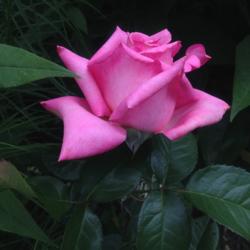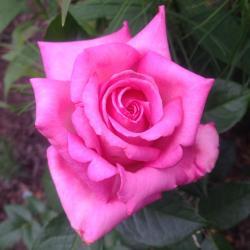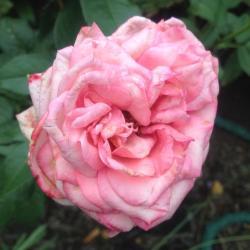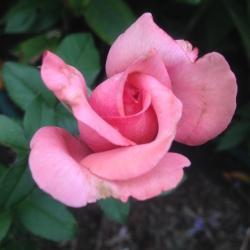gemini_sage said:Carol, your plant is beautiful! I'm seeing some blooms with similar brown tips due to heat, I think porkpal may be right. I'm not familiar with thrip damage though.
Is your Wedding Bells still blooming?
Neal,
Yes, both of my Wedding Bells are blooming, and all flowers, including buds have brown edges. In addition, their color is kind of washed out compared to the vibrant color of the earliest blooms. The weather is still hot, so perhaps that is the reason they are so ugly. However, I took these photos this morning (August 16) and noticed small fly-like insects on the petals of the second plant. So I googled "thrips" and found a photo that looks all too familiar. So now I am now leaning toward thrips as the likely culprit, although I am puzzled that the Savannah flowers are unaffected.
First Wedding Bells plant:
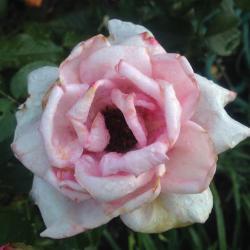
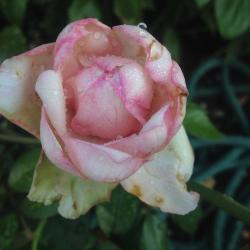
Second Wedding Bells plant:
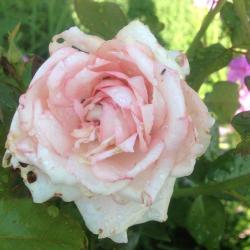
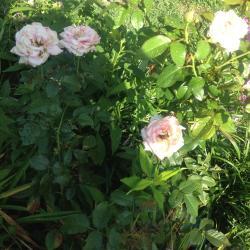
Thrips photo and article (from the Marin Rose Society web site at www.marinrose.org) :
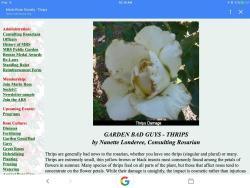
"GARDEN BAD GUYS - THRIPS
by Nanette Londeree, Consulting Rosarian
Thrips are generally bad news to the rosarian, whether you have one thrips (singular and plural) or many. Thrips are extremely small, thin yellow-brown or black insects most commonly found among the petals of flowers in summer. Many species of thrips feed on all parts of the plant, but those that affect roses tend to concentrate on the flower petals. While their damage is unsightly, the impact is cosmetic rather than injurious to the plant.
These little pests are only 1/25" long, and they appear to the naked eye as tiny brown slivers, until they quickly move for cover deeper in the blossom. Damage from thrips usually appears as brown or silver spots or brown edges on petals, particularly on light colored flowers, buds that refuse to open, blooms that "ball" instead of opening properly and deformed buds. If you peel off the petals of a suspect bud, you will probably spot either the thrips themselves or their feces.
The most commonly seen species in roses is the Western Flower Thrips which attack a number of ornamental plants, fruits, and vegetables. Adult thrips have strange, feather-like wings that carry them from flower to flower where they feed on both pollen and plant sap. Their entire life cycle lasts only 40 days so expect many generations per year. Thrips overwinter as pupae and adults in grass clumps, leaf litter and soil. As spring arrives, the pupae hatch to adults. The immature adults begin to feed, and reach sexual maturity in 1 to 4 days. The female cuts a slit in plant tissue into which she inserts a single egg. In about 3 days, a nymph squeezes out of the egg and begins to feed. Over the next 5 days, the nymph goes through two changes, and then enters non-feeding prepupal and pupal stages for a period of 3 days. Most species drop to the soil for the prepupal and pupal stages, although a few stay on the plant for these stages. After the pupal stage, the adult emerges and repeats the cycle. This whole process (from adult to adult) can be completed in as few as 14 days in warm periods. In mild climates, the cycles continue year-round, with as many as 12 to 15 cycles, depending on weather.
Dispersal is primarily on the wind. Although thrips have wings, they tend to rely on wind currents to carry them as much as several miles. Since thrips are poor fliers, they tend to spread slowly through a plant or garden, unless a heavy migration arrives throughout the garden. Heaviest migrations are in May and early June, as buds for the first flush of bloom form.
Controlling thrips can be a bit of a challenge, especially if you use insecticidal sprays. Since they hide and feed deep within the flower bud, the effectiveness of contact materials are reduced. Since they reproduce so quickly, they can rapidly develop resistance to insecticides.
One of the most important things you can do to reduce the population of the pest is to promptly remove spent blooms from your roses and dispose of them (don’t add them to the compost pile). Clean up garden litter from around your roses, especially over winter. Flooding the soil below your plants during peak infestations can drown pupae. Encourage beneficial predators such as lady beetles and aphid lions, (the larvae of lacewing flies), minute pirate bugs, and big-eyed bugs.
You can try horticultural oil and insecticidal soaps; spray as early in the bud stage as you can (before they do any damage). Neem oil also has some effectiveness in reducing thrips populations. Applications should be frequent, as often as every other day, to coincide with the fast life cycle. Insecticides such as Orthene® or Mavrik® are good at controlling thrips, as are a few others."
